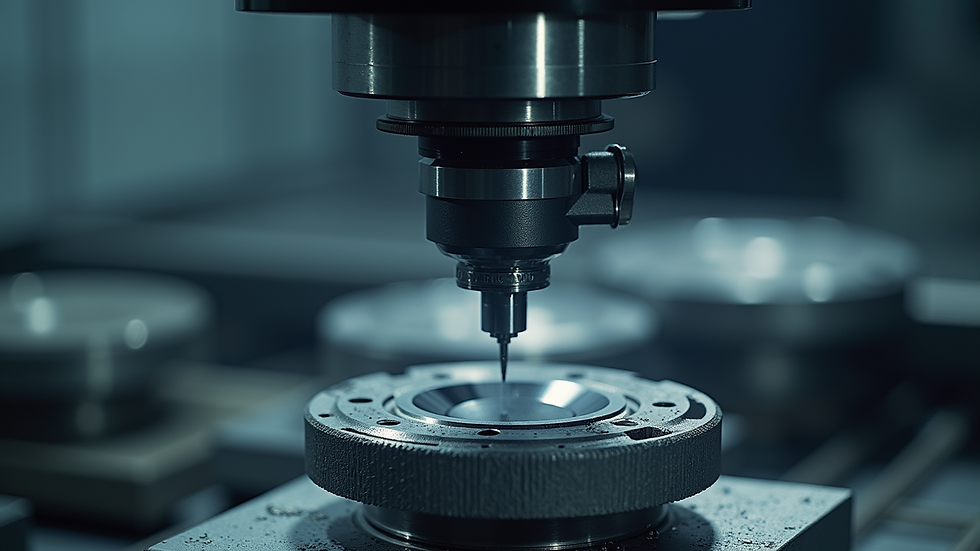5-Axis CNC Machining vs. 3-Axis: Unveiling the Key Distinctions in CNC Milling
- sanshiaerotech
- Apr 14
- 4 min read
CNC machining is essential in today's manufacturing landscape, allowing for high precision and efficiency when producing complex parts. Among the most commonly used methods are 3-axis and 5-axis CNC machining. Each method offers unique advantages and applications, influencing the outcomes based on a project’s specific needs. This post will break down the critical differences between 5-axis CNC machining and 3-axis milling, highlighting their capabilities, benefits, and suitable applications.
Understanding CNC Machining
CNC (Computer Numerical Control) machining uses advanced computerized controls to operate machinery. This technology enables intricate and precise operations that would be tough to achieve manually. By inputting a machine's programming using a CAD design, CNC machining ensures parts are produced with remarkable detail and consistency.
In CNC milling, the machine's axis configuration is crucial for producing complex shapes. The two prevalent types—3-axis and 5-axis—differ significantly in mobility and complexity.
What is 3-Axis CNC Machining?
3-axis CNC machining refers to a process where the cutting tool moves along three axes: X, Y, and Z. The X and Y axes provide horizontal movement, while the Z axis allows for vertical motion. This widely-used method excels at producing simple geometric shapes and is commonly found in various manufacturing processes.
Advantages of 3-Axis Machining
Cost-Effective: Typically, 3-axis machines are less expensive than 5-axis machines. For instance, the cost of a 3-axis CNC machine can range from $30,000 to $50,000, making it an appealing option for small businesses.
Simplicity: The operation and programming of 3-axis systems are generally easier. Operators can learn to use these machines quickly, often increasing productivity significantly.
Wide Usage: 3-axis CNC machining is effective for most traditional materials and excels at applications such as drilling (e.g., PCB manufacturing), milling, and engraving.
Limitations of 3-Axis Machining
Despite its usefulness, 3-axis machining has drawbacks. Complex geometries may require multiple setups since the machine cannot access every contour in one pass. This can lead to longer production times and a higher chance of errors during repositioning.
What is 5-Axis CNC Machining?
5-axis CNC machining builds on traditional milling by incorporating two additional rotary axes, known as A and B axes. This setup allows the cutting tool to approach the workpiece from nearly any angle. As a result, it’s ideal for crafting complex shapes found in advanced manufacturing sectors such as aerospace, automotive, and medical devices.
Advantages of 5-Axis Machining
Complex Part Design: The 5-axis system allows for the creation of intricate designs in one setup, which minimizes setup time and reduces potential errors. For example, in aerospace, certain components can often see a 30% reduction in production time.
Improved Surface Finish: The ability to approach parts from different angles enables more optimal tool paths, leading to higher quality surface finishes. In practical terms, this can mean reduced post-processing and polishing work.
Increased Efficiency: By cutting down on repositioning time and tooling changes, 5-axis machining can boost overall manufacturing efficiency by up to 50%.
Limitations of 5-Axis Machining
While 5-axis machining offers many benefits, it also comes with higher complexity and costs. The machines generally require a larger investment—often exceeding $100,000—along with increased maintenance costs and a need for more skilled operators.
Key Comparisons: 5-Axis vs. 3-Axis
Flexibility in Design
5-axis CNC machining stands out in design flexibility. The extra axes make it possible to create intricate geometries that 3-axis systems cannot achieve without repositioning. For industries focused on innovation, such as aerospace or biomedical engineering, 5-axis machining is often the better option.
Precision and Accuracy
Both machining methods deliver high precision, but 5-axis machining often outperforms with complex parts due to its consistent tool engagement with the material. This not only reduces tool wear but also elevates overall product quality.
Production Time
When comparing production times, 5-axis machines significantly reduce the time needed to produce parts. For instance, eliminating the need for multiple setups can shave off hours from a job's timeline, saving both time and labor costs.
Applications of 3-Axis and 5-Axis CNC Machining
Ideal Applications for 3-Axis CNC Machining
Simple Geometries: Best suited for tasks like drilling, basic milling, and engraving often found in consumer products.
Woodworking: Frequently used in crafting simple wooden parts and furniture, often leading to high-volume production runs.
Cost-Sensitive Projects: Excellent for smaller production runs where budget considerations are essential.
Ideal Applications for 5-Axis CNC Machining
Aerospace Components: Essential for producing intricate parts in aircraft manufacturing, where precision is critical, and complex geometries are commonplace.
Medical Devices: Capable of creating sophisticated and precise components for medical devices, where accuracy can be a matter of safety.
Automotive Engineering: Commonly used to design high-precision components made to specific geometrical requirements, enhancing vehicle performance.
Making Informed Decisions
In summary, both 3-axis and 5-axis CNC machining have distinct advantages that depend on the project requirements. While 3-axis systems tend to be more budget-friendly and simpler for straightforward designs, 5-axis machining offers unmatched precision and adaptability needed for complex parts. Manufacturers, engineers, and students should evaluate their specific needs and project parameters carefully before choosing between these two CNC machining methods. Understanding the differences can lead to improved efficiency, quality, and innovation in manufacturing processes.






Comments